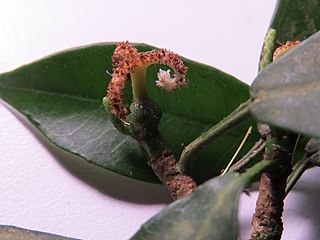
Rio de Janeiro, or simply Rio, is the capital of the state of Rio de Janeiro. It is the second-most-populous city in Brazil and the sixth-most-populous city in the Americas.

Rio de Janeiro is one of the 27 federative units of Brazil. It has the second largest economy of Brazil, with the largest being that of the state of São Paulo. The state, which has 8.2% of the Brazilian population, is responsible for 9.2% of the Brazilian GDP.

Niterói is a municipality in the state of Rio de Janeiro, in the southeast region of Brazil. It lies across Guanabara Bay, facing the city of Rio de Janeiro and forming part of the Rio de Janeiro Metropolitan Area. It was the capital of Rio de Janeiro, as marked by its golden mural crown, from 1834 to 1894 and again from 1903 to 1975. It has an estimated population of 515,317 inhabitants (2020) and an area of 129.375 km2 (49.952 sq mi), making it the fifth most populous city in the state. It has the highest Human Development Index in the state and the seventh highest among Brazil's municipalities in 2010. Individually, it is the second municipality with the highest average monthly household income per capita in Brazil and appears in 13th place among the municipalities of the country according to social indicators related to education. The city has the nicknames of Cidade Sorriso.

The Campeonato Carioca, officially known as Campeonato Estadual do Rio de Janeiro, also commonly known as the Cariocão, is the state football league of Rio de Janeiro, Brazil. It is under the authority of the FERJ or FFERJ. It is an annual tournament, started in 1906.

Algernonia is a plant genus of the family Euphorbiaceae first described as a genus in 1858. It is native to Peru and Brazil.

Seropédica is a municipality located in Greater Rio de Janeiro, Brazil, 75 km from the state capital of Rio de Janeiro. Its population was 83,092 (2020) and its area is 284 km².

Joaquim Manuel de Macedo was a Brazilian novelist, medical doctor, teacher, poet, playwright and journalist, famous for the romance A Moreninha. He is considered the first Brazilian novelist.

The Carnival in Rio de Janeiro is a festival held every year before Lent; it is considered the biggest carnival in the world, with two million people per day on the streets. The first Carnival festival in Rio occurred in 1723.

Manuel José de Araújo Porto-Alegre, Baron of Santo Ângelo, was a Brazilian Romantic writer, painter, architect, diplomat and professor, considered to be one of the first Brazilian editorial cartoonists ever. He is the patron of the 32nd chair of the Brazilian Academy of Letters.

Campomanesia is a genus in the family Myrtaceae described as a genus in 1794. It is native to South America and Trinidad.
José Mariano de Conceição Vellozo (1742–1811) was a Colonial Brazilian botanist who catalogued specimens, for example: Cedrela fissilis Vell. in Florae Fluminensis. He was born in Tiradentes, formerly called São José do Rio das Mortes, state of Minas Gerais; and died in Rio de Janeiro, state of Rio de Janeiro. While at the University of Coimbra in Portugal in the 1790s he worked with Martim Francisco Ribeiro de Andrada in translating works on mineralogy and agriculture. The standard author abbreviation Vell. is used to indicate this person as the author when citing a botanical name.
Muyelensaurus is a genus of titanosaurian sauropod dinosaur from the Late Cretaceous of Argentina. It was more slender than other titanosaurs. Fossils have been recovered in the Neuquén province of Patagonia and were originally assigned to the Portezuelo Formation but further research showed that these layers belong to the Plottier Formation. The type species is M. pecheni. The name Muyelensaurus first appeared in a 2007 paper by Argentine paleontologists Jorge Calvo of the Universidad Nacional del Comahue and Bernardo González Riga of the Laboratorio de Paleovertebrados, and Brazilian paleontologist Juan Porfiri of the Universidade Federal do Rio de Janeiro.
The Federação de Futebol do Estado do Rio de Janeiro, usually known by the acronyms FERJ and FFERJ, manages all the official football tournaments within the state of Rio de Janeiro including the Campeonato Carioca, the Campeonato Carioca Série B1, the Copa Rio, and the Campeonato Carioca de Futebol Feminino. It was founded in 1978.

The Federal University of the State of Rio de Janeiro is a federally funded public university located in the State of Rio de Janeiro, Brazil. It has several campuses in the city of Rio de Janeiro, including two in the Urca neighborhood.

Emil Bauch was a German painter, lithographer and teacher who came to reside in the city of Rio de Janeiro. He painted panoramic city scenes and portraits, as well as some views of Recife and Salvador. His landscapes are conspicuous by his close observation of all the details and the intense variety of motifs of his palette. His works have all but disappeared in the shadow of paintings created by other artists during the second half of the nineteenth century in Brazil.

Cortana is a fossil genus of medium-sized air-breathing land snails, terrestrial pulmonate gastropods in the family Bulimulidae. The genus is known only from the Brazilian Paleocene deposits of the Itaboraí Basin, in the state of Rio de Janeiro. The most characteristic feature of the genus is its apertural armature.

Barjonia is a genus of flowering plants in the family Apocynaceae, first described as a genus in 1844. They are native to South America.
Nephradenia is a genus of plants in the family Apocynaceae, first described as a genus in 1844. They are native to South America.

Peplonia is a group of plants in the family Apocynaceae first described as a genus in 1844. The entire genus is endemic to Brazil.
Hemipogon is a genus of flowering plants in the family Apocynaceae, first described as a genus in 1844. It is native to South America.














